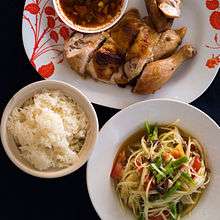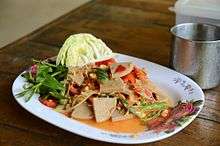Green papaya salad
 A dish of green papaya salad, made with papaya, beans, chili, pla ra, brined crab, hog plum, and lime | |
| Alternative names | tam maak hoong, bok l'hong, tam som, som tam and gỏi đu đủ |
|---|---|
| Type | Salad |
| Place of origin | Laos |
| Region or state | Nationwide |
| Main ingredients | Papaya |
Green papaya salad is a spicy salad made from shredded unripe papaya. Probably originating from ethnic Lao people, it is also eaten throughout Southeast Asia. Locally known in Cambodia as bok l'hong (Khmer: បុកល្ហុង, pronounced [ɓok lhoŋ]), in Laos as tam som (Lao: ຕໍາສົ້ມ) or the more specific name tam maak hoong (Lao: ຕໍາໝາກຫຸ່ງ, pronounced [tàm.ma᷆ːk.hūŋ]), in Thailand as som tam (Thai: ส้มตำ, pronounced [sôm tām]), and in Vietnam as gỏi đu đủ. Som tam, the Thai variation, was listed at number 46 on World's 50 most delicious foods compiled by CNN Go in 2011.[1]
History
The green papaya salad was adapted from an ethnic Lao dish known as tam som (literally "pounding [of] sour [ingredients]"), which used local fruits and vegetables such as green (unripe) mango or cucumbers as the main ingredient, seasoned to a primarily sour flavour. Following the Columbian Exchange, the papaya was introduced into Siam (now Thailand) via Malacca. According to historian Sujit Wongthes, the variant of tam som using papaya as the main ingredient probably originated in the communities of ethnic Chinese–Lao settlers living in the Chao Phraya plains of what is now Central Thailand—where it became known as som tam—during the early Rattanakosin period (late 18th to early 19th centuries). The new dish, along with the papaya, then spread to today's Northeast Thailand (Isan) following the construction of the Northeastern railway line during the turn of the 19th–20th centuries, and became more popular after the opening of Mittraphap Road in 1957 helped bring new papaya cultivars into the region. The dish has since become widely adopted by the ethnic Lao people of both Isan and Laos. Likewise, the hot flavour also spread to Isan and Laos from Central Thailand, which had been introduced to chilli peppers first. Historically, hot spiciness was not a dominant feature of Lao/Isan cuisine.[2]
Preparation
The dish combines the five main tastes of the local cuisine: sour lime, hot chili, salty, savory fish sauce, and sweetness added by palm sugar. The ingredients are mixed and pounded in a mortar. As the name tam som suggests, sourness is a dominant taste; however, the more specific Lao name tam maak hoong literally means "pounded papaya". In Khmer, the name bok l'hong also means "pounded papaya". In Thai, the name som tam is simply a reversal of the Lao name. However, other pounded salads in Thailand are consistent with the Lao naming convention in which the word tam ("pounded") is listed first.
Despite the use of papaya, which one may think of as sweet, this salad is actually savory. When not yet ripe, papaya does not has tangy flavor. The texture is crisp and firm, sometimes to the point of crunchiness. It is this that allows the fruit to withstand being beaten in the mortar.
In Laos, green papaya salad is one of the traditional staples of the Lao. Pounded salads in Laos all fall under the parent category of tam som, which may or may not contain green papaya, however, when no specific type of tam som is mentioned, it is generally understood to refer to green papaya salad. For absolute clarity, however, the name tam maak hoong may be used, since this name means "pounded papaya".
In Thailand, it is customary that a customer ask the preparer to make the dish suited to his or her tastes. To specifically refer to the original style of papaya salad as prepared in Laos or Isan, it is known as ส้มตำลาว or som tam Lao or simply as tam Lao, and the dish as prepared in central Thailand may be referred to as som tam Thai.[3]
Traditionally, the local variety of green papaya salad in the streets of Bangkok is very hot due to the addition of a fistful of chopped hot bird's eye chili. However, with its rising popularity among tourists, it is now often served not as hot.
Additional ingredients


Together with the papaya, some or most of the following secondary items are added and pounded in the mortar with the pestle:
- Asparagus beans
- Brined "rice field crabs". These belong to the freshwater crab genera Sayamia, Chulathelphusa, and Esanthelphusa (previously classified as part of Somanniathelphusa), which all belong to the family Parathelphusinae.[4][5] found in flooded rice fields and canals. Isan people eat the entire crab, including the shell.
- Chili pepper
- Dried shrimp
- Fish sauce
- Garlic
- Hog Plums
- Lime
- Palm sugar
- Shrimp paste
- Pla ra / padaek
- Raw Thai eggplant
- Tomatoes
Green papaya salad is often served with glutinous rice and kai yang/ping gai (grilled chicken). It can also be eaten with fresh rice noodles (Lao: sen khao poon / Thai: khanom chin) or simply as a snack by itself with, for instance, crispy pork rinds. The dish is often accompanied by raw vegetables on the side to mitigate the spiciness of the dish.
Variations
Green papaya salad is claimed as an innovation of the Lao people.[6][7] Variations of the dish are found throughout Thailand, Cambodia, Vietnam, and as well as in the West, where it is more commonly known by its Thai name.[8][9]
A non-spicy green papaya salad version also exists in Laos, Vietnam, and Thailand, which is much sweeter; it often contains crushed peanuts, and is less likely to have padaek or brined crab.[10] Dried brine shrimp are used in this Central Thai version. There are also versions that make use of unripe mangoes, apples, cucumbers, carrots, and other firm vegetables or unripe fruit. Besides using varieties of fruits or vegetables as the main ingredient a popular option is to use vermicelli rice noodle wherein the dish is known as tam sua.
Instead of papaya, other ingredients can be used as the main ingredient. Popular variations in Laos and Thailand include:
- Tam maak taeng / Tam taengkwa, with cucumber, usually the small variety
- Tam maak muang / Tam mamuang, with green and unripe mango
- Tam maak kuai / Tam kluai, with banana, while still green and unripe
- Tam krathon, with santol, while still hard and unripe
- Tam hua pli, with banana flower
- Tam mayom, with Malay gooseberry
- Tam som o, with pomelo
- Tam mu yo, with mu yo sausage
- Tam phonlamai ruam, with mixed fruit
Gallery
- Som tam Thai, which contains peanuts, is the Central Thai variant that became famous internationally
 Som tam pu, a Thai green papaya salad with brined rice paddy crabs
Som tam pu, a Thai green papaya salad with brined rice paddy crabs Tam phonlamai ruam: a variation of the dish with mixed fruit
Tam phonlamai ruam: a variation of the dish with mixed fruit Tam hua pli: a variation with banana flower
Tam hua pli: a variation with banana flower Tam mu yo: a variation with mu yo sausage
Tam mu yo: a variation with mu yo sausage Tam mamuang pla haeng thot: a variation with green mango and dried anchovies
Tam mamuang pla haeng thot: a variation with green mango and dried anchovies Tam maphrao on sen mi krop: a variation with soft coconut meat and deep-fried rice noodle
Tam maphrao on sen mi krop: a variation with soft coconut meat and deep-fried rice noodle- Tam som o nam pu: pounded pomelo salad with crab extract (a specialty of northern Thailand)
See also
References
- ↑ CNN Go World's 50 most delicious foods: place 46 Som tam, Thailand 21 July 2011. Retrieved 2011-10-11
- ↑ "′มะละกอ′มีกำเนิดจากทวีปอเมริกา มาเป็น′ส้มตำ′ เริ่มมีในบางกอก - สุวรรณภูมิในอาเซียน" ['Papaya' - originated in the Americas, became 'som tam' in Bangkok]. Matichon (in Thai). 25 December 2014. Archived from the original on 4 March 2016. Retrieved 29 July 2017.
- ↑ Maitreya. "Lord of Suvarnabhumi". lordofgoldenland.blogspot.ca. Retrieved 11 April 2015.
- ↑ Ponchunchoovong, Samorn (2006). Species identification of Thai Rice-field Crab in the lower north-eastern region of Thailand.
- ↑ Species identification of Thai Rice Field Crab Archived 28 March 2012 at the Wayback Machine.
- ↑ "Khe-Yo's Chef Soulayphet Schwader on Laotian Cuisine and the Perfect Bite". seriouseats.com. Retrieved 11 April 2015.
- ↑ Lee, Jonathan H. X., and Kathleen M. Nadeau. "Laotian Americans: Foods and Foodways." Encyclopedia of Asian American folklore and folklife. Santa Barbara, Calif.: ABC-CLIO, 2011. 733. Print
- ↑ "EatingAsia". typepad.com. Retrieved 11 April 2015.
- ↑ "The tao of papaya". LasVegasWeekly.com. 5 January 2010. Retrieved 11 April 2015.
- ↑ "Clay's Kitchen : Tam Ra Ahan Thai (Thai Recipes) ตำราอาหารไทย". panix.com. Retrieved 11 April 2015.
Further reading
- Cummings, Joe. (2000). World Food: Thailand. UK: Lonely Planet Publishers. pp. 157–8. ISBN 1-86450-026-3
- Williams, China ‘’et al.’’. (). ‘’Southeast Asia on a Shoestring: Big Trips on Small Budgets.’’ Lonely Planet. p. 31. ISBN 1-74104-164-3
- Brissenden, Rosemary. (2007). Southeast Asian food: Classic and Modern Dishes from Indonesia, Malaysia, .. Tuttle Publishing. pp. 434 – 439. ISBN 0-7946-0488-9
- McDermoot, Nancie. (1992). Real Thai: The Best of Thailand’s Regional Cooking. Chronicle Books. pp. 121 – 146. ISBN 0-8118-0017-2
External links
| Wikimedia Commons has media related to |
- Video of how to make Thai Som tam
- History of Thai Som tam
- www.highheelgourmet.com: Thai Som Tam recipe